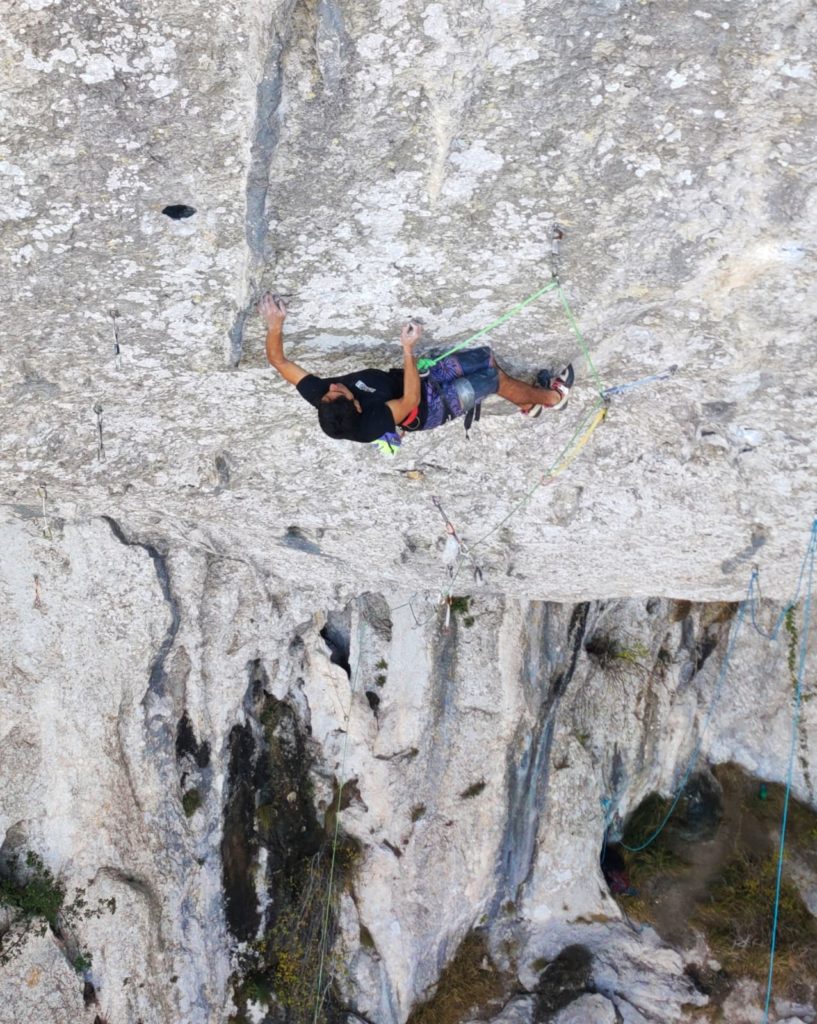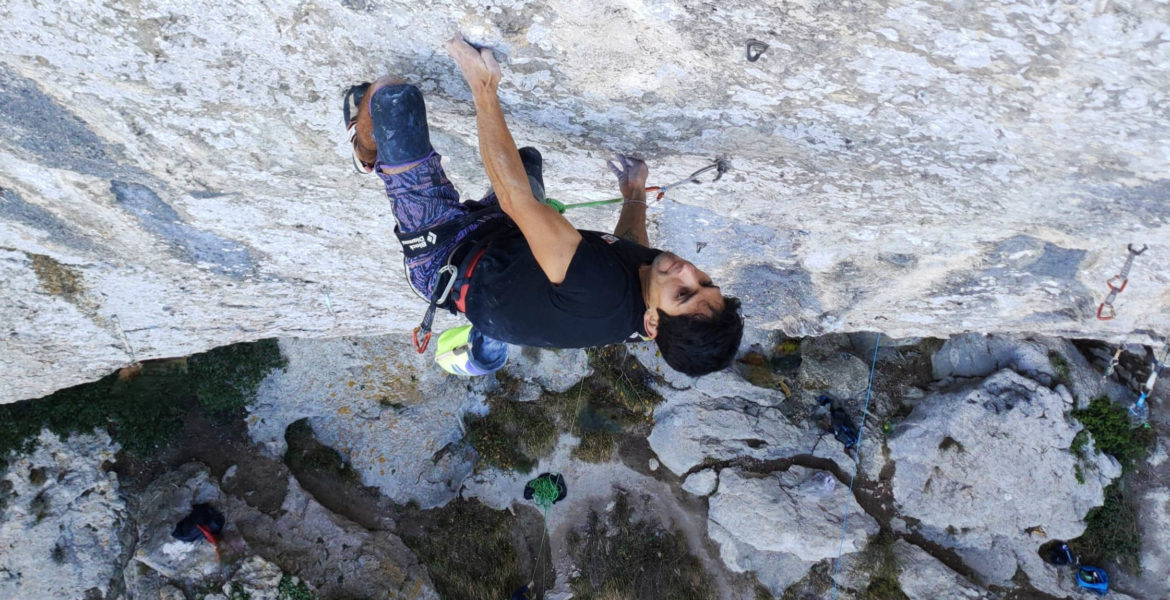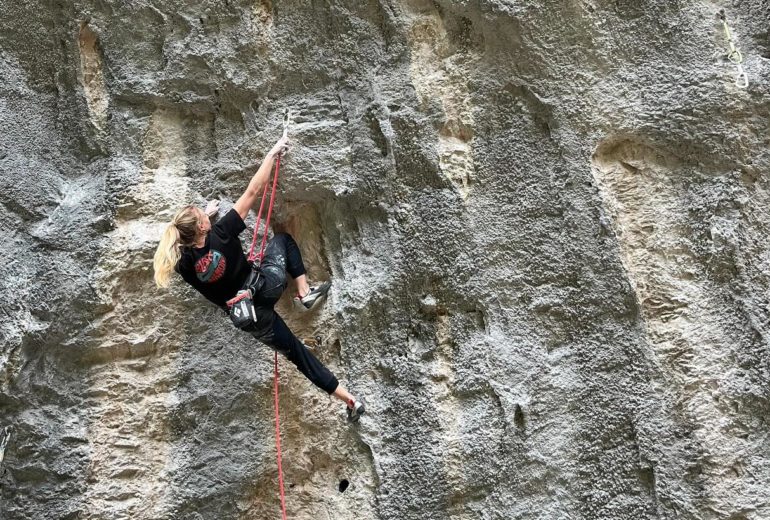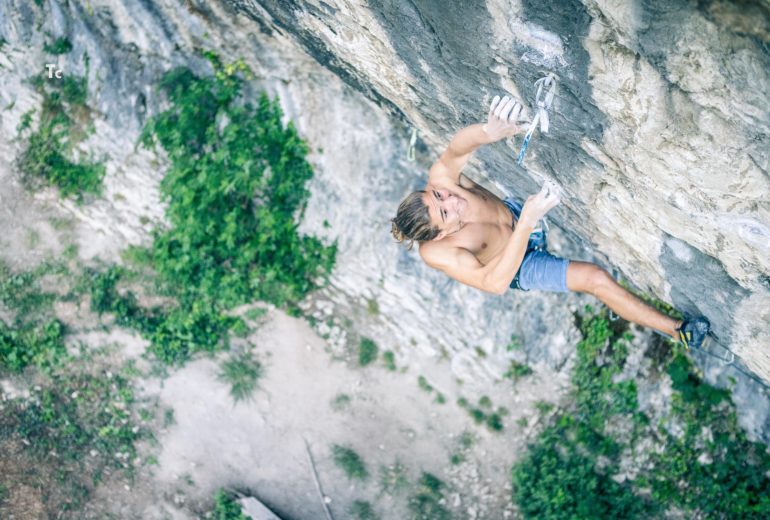Comme dans la célèbre baume de la Ramirole dans le Verdon, les répétitions de voies extrêmes en 9ème degré ne sont pas légion au Pic St-Loup. « Moksha » (8c+/9a) et la première partie de « Beyond » ont reçu quelques répétitions ces dernières années, et c’est à peu près tout. Dernièrement, « Staphylocoque », une ligne majeure en 9a/+ de 50 mètres de long équipée par Fédric Ferarro, a récemment décerné le grade de nonogradiste à deux grimpeurs locaux, concrétisant leur projet à long terme : Maxime Bach et Sebastian Bravo. La première ascension de la voie avait été réalisée par Cédric Lachat en 2014. Depuis Hugo Meignan (août 2014) et Seb Bouin (printemps 2015) avaient réussi la voie, qui est retombée dans l’oubli 10 ans. Rencontre avec Sebastian, le plus montpelliérain des grimpeurs chiliens, un mordu de caillou particulièrement fanatique et sympathique, qui n’hésite pas à porter un énorme melon d’eau sur la terrible marche/remontée de stats de la falaise pour en faire profiter toute les grimpeurs présents !
Salut Seba ! Est-ce que tu peux te présenter ?
Je m’appelle Sebastian, je viens du Chili mais ça fait 7 ans que j’habite en France. J’étais venu pour un an seulement à la base, pour découvrir des nouvelles falaises et grimper sur du calcaire : au Chili il y a très peu de falaises en calcaire. Et au final ça m’a tellement plu que je suis resté !
Comment s’est déroulé le processus de travail de la voie ? Depuis combien de temps est-ce que tu la travailles ? Quelles sont les autres voies de la baume que tu avais faites avant ?
J’ai essayé « Staphylocoque » pour la première fois fin novembre de l’année dernière, après avoir enchaîné « Snails Intégral », un 8c+/9a long et intense avec une section sur sur petites prises à la fin et un dynamique pour aller à une bonne prise à côté du relais. À ce moment-là je savais que je voulais essayé quelque chose de plus dur et comme Max Bach, un copain, était en train d’essayer Staphilo, je l’ai suivi dans cette voie. Dès le premier essai j’ai adoré la voie, elle était magnifique avec des mouvements techniques bien exigeants. J’avais trouvé mon prochain projet. J’ai fait quelques montées dedans en novembre avant que la pluie et le froid arrivent. Puis j’y suis retourné aux beaux jours, en juin. Après plusieurs essais, j’ai réussi à faire tous les moves en juillet et ça me motivé parce qu’à ce moment-là je savais que je pouvais enchaîner. En août je suis parti à Flatanger pour échapper à la chaleur, je suis revenu en septembre mais j’ai pas pu retourner dans la voie tout de suite car j’ai commencé une formation DEJEPS canyoning. J’étais en déplacement la semaine donc c’était même difficile de trouver le temps de s’entraîner. Je grimpais le weekend les fois où je revenais à Montpellier. Mi-octobre finalement j’ai eu plus de temps libre, et malgré mon travail de cordiste la semaine j’ai eu du temps pour m’entraîner et grimper, et j’ai enchaîné la voie dimanche 26.

Est-ce que tu peux nous décrire la voie ?
Pour moi la voie est une des plus belles que j’ai essayées. Il y a une belle variété de mouvements et aussi tous les types de prises possible : bidoigts, plats, règles, colos, inversées… Tout ce qu’il faut pour s’amuser et faire de la grimpe un beau voyage de 50m. La voie partage son départ avec Helix (8c/+), continue dans Mokcha (8c+/9a) et termine sur une partie plus raide où se trouve le crux de Staphylo. La voie commence donc avec un bloc en 7C classique. Puis on rejoint ensuite une traversée technique sur petites prises jusqu’à arriver avec un pseudo dynamique dans un trou. Là se trouve un repos et jusqu’ici t’as quasiment fait Mokcha, coté 8c+, mais la voie continue tout droit. Commence alors ma section préférée, des grands moves sur des pinces un peu plates puis un mouvement dynamique pour aller chercher un tri-doigt et une inversée pour relancer dans une grosse colo. On peut caler un genou et c’est le dernier repos avant d’attaquer le crux. Le repos dans la colo est pas confortable parce qu’il fait affreusement mal au pied, du coup j’étais au obligé de délayer mes bras puis mes jambes et ainsi de suite. Là commence la partie dure donc des moves plus difficiles sur 4 points, on en clippe seulement deux. Un section avec des mauvaises inversées avec des pieds à plat un peu glissants. Après la fin du crux il reste un espèce de 8a/+ jusqu’à au relais avec des moves loin vraiment dynamiques et très très beaux 🙂
Quel a été ton parcours ? Pourquoi es-tu venu en France ?
J’ai commencé l’escalade à 18 ans au Chili, j’ai rapidement passé mon temps à grimper et fait pas mal de compétition. Mais ma passion c’était plutôt la falaise et c’est une des raisons de mon voyage en France.
Le but du voyage était de faire un an d’escalade en grimpant des voies les plus dures possibles et apprendre à grimper en calcaire. Dès que je suis arrivé je suis allé dans les gorges du Verdon, j’ai grimpé à la Ramirole et ça a été le coup de foudre ! Quelques années plus tard j’y suis retourné trois saisons de suite pour travailler en tant que moniteur d’escalade et pouvoir connaître mieux cet endroit magnifique.
Maintenant j’habite à Montpellier, on a pas mal de secteurs d’escalade proches, dont le Pic bien sûr !
Et la suite ? Est-ce que tu as d’autres projets en tête ?
Pour la suite je vais essayer « Kmira » pour profiter du fait que je connais déjà la fin ! J’aimerais beaucoup essayer « Beyond » si j’ai le temps, finalement c’est ça le plus difficile !
Photos : coll. Bravo
As in the famous Baume de la Ramirole in the Verdon, repeats of extreme 9th grade routes are few and far between at Pic St-Loup. “Moksha” (8c+/9a) and the first part of “Beyond” have been repeated a few times in recent years, and that’s about it. Recently, “Staphylocoque,” a major 50-meter-long 9a/+ route bolted by Fédric Ferarro, awarded the grade of nonogradists to two local climbers who had been working on the project for a long time: Maxime Bach and Sebastian Bravo. The first ascent of the route was made by Cédric Lachat in 2014. Since then, Hugo Meignan (August 2014) and Seb Bouin (spring 2015) had repeated the route, which had fallen into oblivion for 10 years. We meet Sebastian, one of the most French of Chilean climbers, a particularly fanatical and friendly climber, who doesn’t hesitate to carry a huge watermelon up the terrible approach that all the climbers present at the crag can enjoy it!
Hi Seba! Can you introduce yourself?
My name is Sebastian, I’m from Chile but I’ve been living in France for seven years. I originally came for just one year, to discover new cliffs and climb on limestone: in Chile there are very few limestone cliffs. And in the end I liked it so much that I stayed!
How did the process of working on the route go? How long have you worked it for? What other routes at the crag have you done before?
I tried ‘Staphylocoque’ for the first time at the end of November last year, after completing ‘Snails Intégral’, a long and intense 8c+/9a with a section on small holds at the end and a dynamic move to reach a good hold next to the belay. At that point, I knew I wanted to try something harder, and since my friend Max Bach was trying Staphilo, I followed him on that route. I loved the route from the first attempt; it was magnificent with some very demanding technical moves. I had found my next project. I had a few runs in November before the rain and cold set in. Then I went back when the weather improved in June. After several attempts, I managed to do all the moves in July, which motivated me because at that point I knew I could do it. In August, I went to Flatanger to escape the heat. I came back in September, but couldn’t get back on the route straight away because I started a DEJEPS canyoning training course. I was away during the week, so it was even difficult to find time to train. I climbed at the weekend when I returned to Montpellier. In mid-October, I finally had more free time, and despite my work as a rope access technician during the week, I had time to train and climb, and I completed the route on Sunday 26th.
Can you describe the line for us?
For me, this route is one of the most beautiful I’ve ever tried. It offers a nice variety of movements and all types of holds: 2-finger pockets, sloppers, crimps, pinches, underclings… Everything you need to have fun and make climbing a beautiful 50-metre journey. The route shares its start with Helix (8c/+), continues into Mokcha (8c+/9a) and ends on a steeper section where the crux of Staphylo is located. So, the route starts with a classic 7C boulder. Then you reach a technical traverse on small holds until you get to a pseudo-dynamic move into a pocket. There’s a rest there, and at this point you’ve almost done Mokcha, rated 8c+, but the route continues straight on. Then comes my favourite section, big moves on slightly flat pinches, then a dynamic move to reach a three-finger hold and an undercling from where you launch for a big tufa. You can wedge your knee in, and this is the last rest before tackling the crux. That rest isn’t comfortable because it hurts your foot terribly, so I had to stretch my arms, then my legs, and so on. This is where the hard part begins, with more difficult moves over four bolts, only two of which can be clipped. A section with bad underclings with slightly slippery flat feet. After the end of the crux, there is a sort of 8a/+ to the belay with really dynamic and very beautiful long moves 🙂
What has been your journey? Why did you come to France?
I started climbing at the age of 18 in Chile, and I quickly spent all my time climbing and competing quite a bit. But my passion was more for crag climbing, and that’s one of the reasons I travelled to France. The aim of the trip was to spend a year climbing the hardest routes possible and learn how to climb on limestone. As soon as I arrived, I went to the Gorges du Verdon, climbed at La Ramirole, and it was love at first sight! A few years later, I went back three seasons in a row to work as a climbing instructor and get to know this magnificent place better.
Now I live in Montpellier, where there are quite a few climbing areas nearby, including the Pic, of course!
What’s next? Do you have any other projects in mind?
Next, I’m going to try ‘Kmira’ to take advantage of the fact that I already know the end! I’d really like to try ‘Beyond’ if I have time, but ultimately that’s the hardest part!
Photos : coll. Bravo






